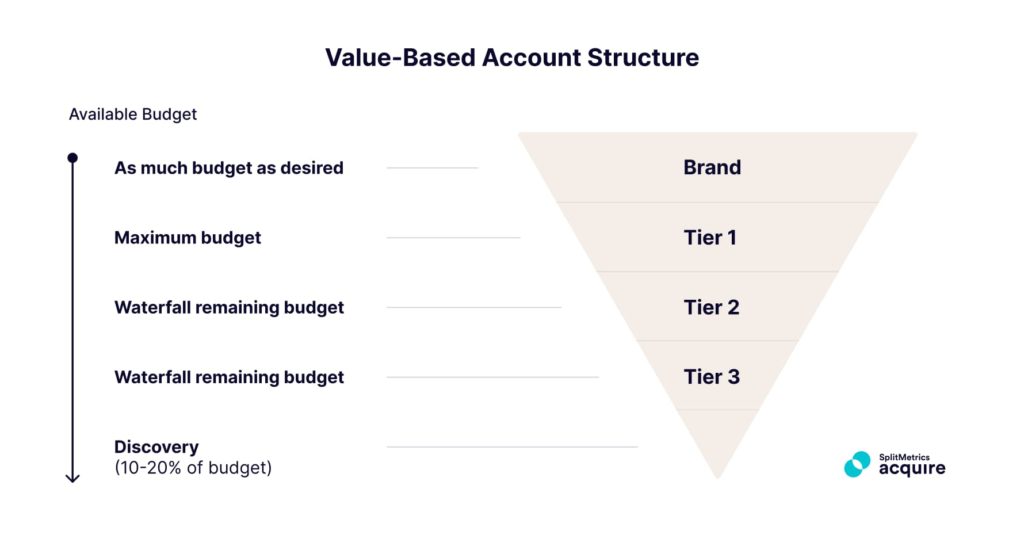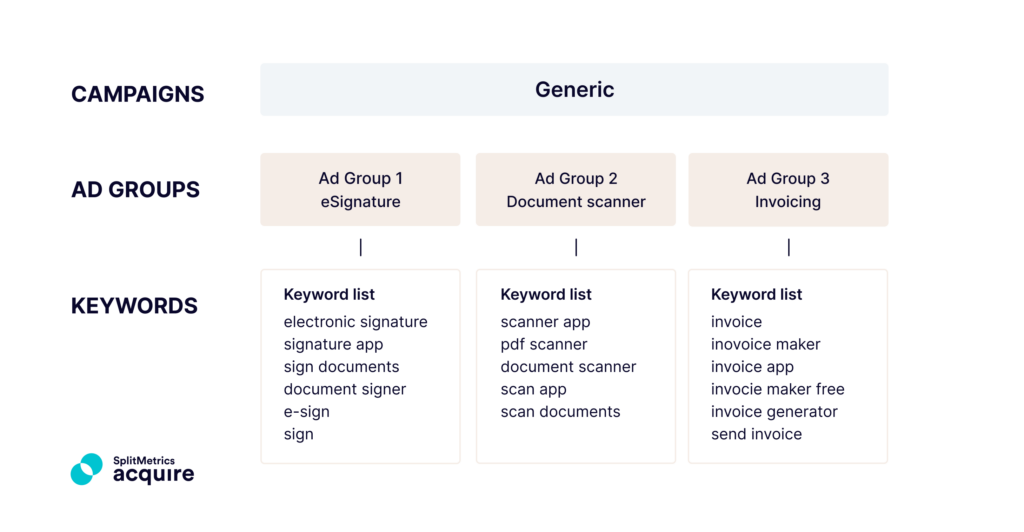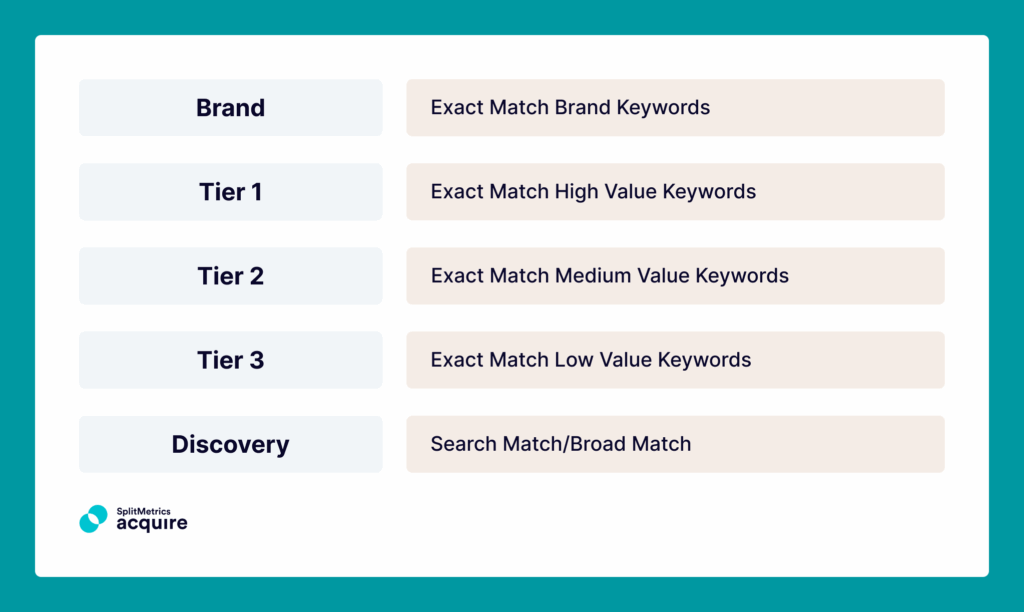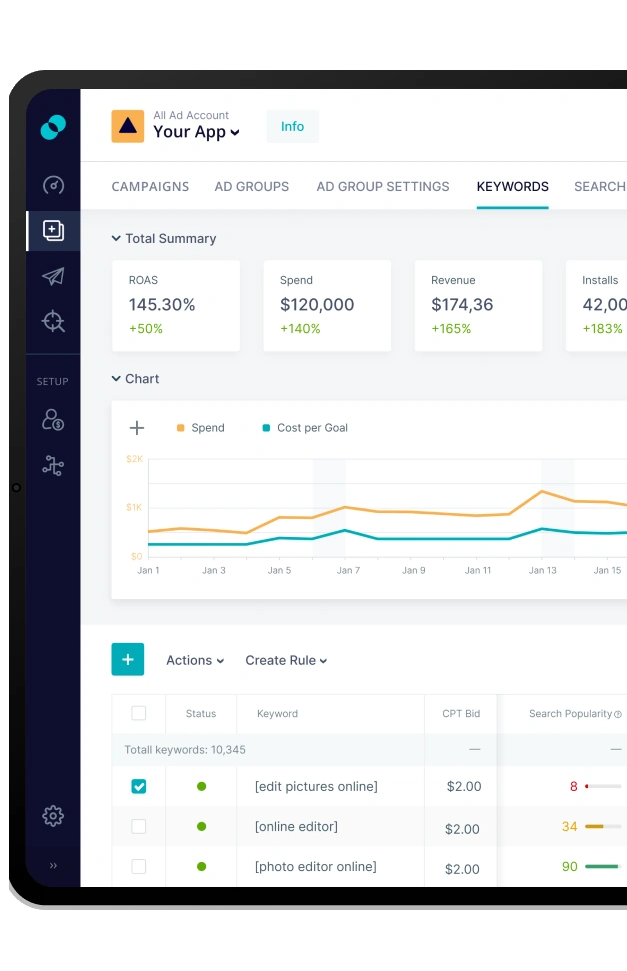How to Build a Value-Based Apple Ads Campaign Structure for Search Results Ads
 Gabriel Kuriata
Gabriel Kuriata  Gabriel Kuriata
Gabriel Kuriata The value-based campaign structure of Apple Ads search results ads organizes keywords into tiers by their ability to drive revenue, prioritizing the most profitable ones. Its implementation relies on evaluating keyword performance on revenue-related post-installation metrics.
That said, the value-based campaign structure is an alternative to the semantics-based one which categorizes keywords by their themes, a solution suitable for all advertisers regardless of scale. The key reason some explore the value-based approach is that its focus on revenue (purchases and return on ad spend) fosters a framework for possibly improved profitability. See our comparative guide to understand all the differences between the two structures.
A value-based approach to organizing keywords can potentially improve the profitability of your Apple Ads campaigns. This is why key concepts of this structure can be used in the most popular semantics-based method. Continue reading to find out how!

The value-based campaign structure is recommended for advanced users because it greatly benefits from two factors:
The value-based structure requires connecting the Apple Ads campaign data with in-app engagement monitoring provided by a mobile measurement partner (MMP) and applying this unified data in day-to-day optimization and management. Understanding all key Apple Ads metrics and the app’s business goals is crucial to succeeding with this structure.
Also, it may be challenging to manage without some degree of automation to aid analysis, budget waterfalling, and managing bidding strategies appropriate for each campaign, depending on the value it provides.
SplitMetrics Acquire offers many additional features for managing and analyzing Apple Ads. It allows flexible automation and unifies all pre- and post-installation data for a full-funnel view of performance, enabling users to rely on it in day-to-day optimization and management.
All these factors explain why the value-based campaign structure is typically achieved in steps as an expansion of the most popular semantics-based campaign structure, typically concerning category campaigns. Find out how it’s done in our guide to building a semantics-based campaign structure in Apple Ads.

Regardless of all the considerations, it’s worth investigating this concept, as this structure is the ultimate data-driven approach to optimizing and managing Apple Ads. Adequately implemented, the value-based campaign structure can contribute to a much more effective ROI.
The recommended structure should have the following campaigns:
The Discovery and Brand campaigns are handled in the same way they would be in the semantics-based Apple Ads campaign structure. This means that the brand campaign will be assigned as much budget as possible to capitalize on its potential considering its scale, and the discovery campaign will be assigned a specific budget depending on its maturity, app category, and other factors.
We highly recommend our campaign-specific guides on acquiring valuable users with brand campaigns and exploring new opportunities with discovery campaigns.
Tiered campaigns should contain exact-match keywords, and this article will explain their management.
Note the absence of competitors’ campaigns in the default structure. Given that this type of campaign’s primary goal is user acquisition, competitor keywords can be included among the three tiers, with bidding optimized for delivering specific revenue relative to the cost. However, the value-based campaign structure can also have separate competitors’ campaigns.

Grouping keywords into tiers should be driven by the value acquired through them. Your app’s business model should determine a high, medium, or low lifetime value.
There are many factors to consider. Some post-installation activities can be considerably less frequent than others (like subscriptions or high-value in-app purchases). Return on ad spend (ROAS) can also be the primary metric. Thus, for a hypothetical mobile game, we’d prioritize highly-engaged users willing to see and perhaps interact with in-game ads.
There are as many possibilities as apps with unique customer journeys, lifecycles, and monetization models. However, preparing this structure requires thoroughly understanding all key Apple Ads metrics. Take this example:
In it, keywords are grouped into three tiers depending on the revenue they bring from in-app purchases (the figures displayed are for illustrative purposes only, to show the logic behind structuring). Additionally, they’re split into multiple ad groups within each campaign for more flexibility in optimization, easier management, and more transparent reporting. Consequently, your Apple Ads structure can look the following way:

The structure is flexible enough to allow many approaches to deciding how keywords are split between the tiers. For example:
You’ll greatly benefit from having aggregated historical data before implementing this structure. It’s another argument for gradually implementing this type of structure after working with the semantics-based one. If impossible, thorough, data-driven keyword research will help you make assumptions as close to reality. Nonetheless, you should be prepared to closely monitor keyword performance and rearrange them between tiers as needed.
The necessity of having accurate data to assess keyword value properly makes a probing (or proxy) campaign an indispensable part of the value-based campaign structure.
The probing/Proxy campaign tests the potential revenue-generating power of newly found search terms in the discovery campaign.
When creating a proxy campaign, fill it with keywords you discovered as an exact match. They should stay in this group unless you have enough data on their performance. Keep in mind that bids should be competitive enough to aggregate data on keyword performance.
When it comes to defining bids, there are two common scenarios:
SplitMetrics Acquire offers an automation rule template called “Impression booster for new keywords,” which will boost new keywords to the auction, gradually increasing bids until they reach the competitive bid. Use it to manage your probing campaign automatically.
Probing campaigns should be run carefully to deliver on their premise without sacrificing unnecessary resources. This means that keywords shouldn’t spend any more time than necessary before they’re either transferred into a designated exact-match tier or paused.
It’s best to automate bidding in a proxy campaign and set up alerts when keywords are ready to be transferred.
Budget waterfalling involves assigning a budget according to campaign priority. This process ensures that the budget is prioritized by the keywords driving value. Consequently, your brand campaign will have as much budget as possible. Start there and then divide the remaining budget among the tiered campaigns. It’s possible some assumptions may be inevitable in the beginning, so make sure you monitor performance and spend to make adjustments as quickly as possible.
There are several important considerations before committing to this type of campaign structure.
The highest-value keywords may deliver a fraction of the finalized goals, while the low-value keywords may have the most significant scale. For example, your brand campaign may perform splendidly on a keyword level but still contribute a fraction of your overall goals unless you strategically build your brand awareness. Similarly, a significant pool of less popular category keywords may deliver the bulk of your revenue.
You’ll need to consider all these factors while deciding how to distribute your budget and configure daily budgets for the best performance.
Individual keywords’ values change over time, requiring re-categorizing according to their updated value. Moving keywords around should always be done with careful consideration.
The probing campaign is essential to the value-based structure delivering real-life performance data on keywords. Anything but the data-driven approach, even the best-educated guess, can be risky.
This approach to tiering keywords and campaigns may initially seem a bit complicated. Still, when done right, such an account structure may bring progressively higher ROI, especially as the scale of your campaign grows, which ultimately enables you to bid even higher and drive additional scale.
Furthermore, suppose you have spare time to master advanced segmentation and efficiency extraction. In that case, you will also learn a new frame of mind that can be applied to other areas of your marketing strategy.

